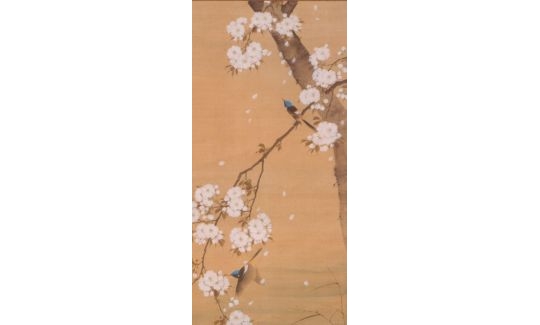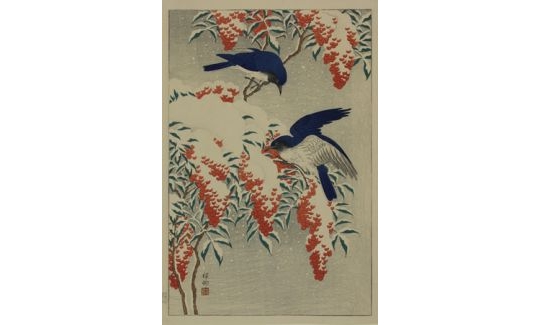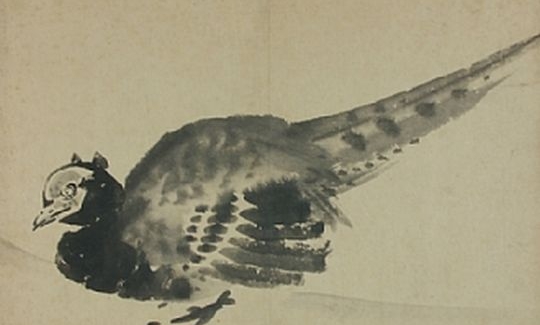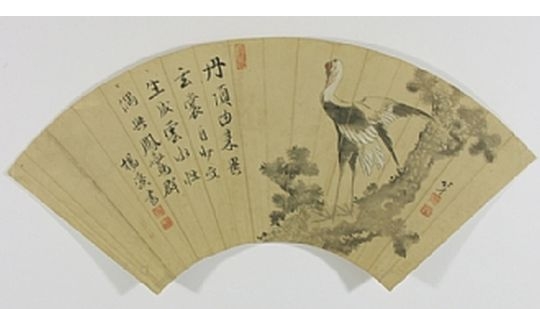Pictures of birds and flowers - in Japanese kacho-e or kacho-ga - were particular favourites of the traditional Japanese artists. Kacho-e is one of the three pictorial motifs deriving from the Chinese classification system. The other two are jimbutsu-ga - portraits, and sansui-ga - landscapes. The decision to represent birds and flowers as a discrete motif was taken in China in the 10th century, during the Sung dynasty (960-1279).
The essential subject of kacho-e is birds together with blossoming trees (kaboku), flowering plants (kaki), or foliage (soka). Lesser categories of kacho-e include fruit and vegetables (sôka), plants and insects (sōchū), and seaweed and fish (sōgyo). Paintings that also include creatures (sōjūga) such as dragons, tigers, monkeys or horses, comprise a separate category.
The theme first appeared in Japan in the Muromachi era (1333-1568) when the Zen monks began making drawings in black ink of bamboo, plum trees or wild grasses combined with geese or other birds, under the influence of the academic Chinese paintings of the Sung and Yuan periods (1279-1368). In the 15th century, professional Japanese artists began making delicate paintings of birds and flowers in the naturalistic, colourful style that prevailed at the Chinese imperial academy of art in the 12th century.
At the end of the 15th century and during the 16th century, more and more Japanese artists began creating kacho-e. Toyo Sesshu
(1420-1506) combined birds and flowers against decorated backgrounds on large screens, depicting aspects of the four seasons. The paintings of Kano Motonobu (1476-1559) were a combination of the Chinese style and the lyrical Japanese yamato-e style. At the close of the 16th century, Kano Eitoku (1543-1590), grandson of Motonobu, was creating colourful, vigorous depictions of birds and flowers on golden backgrounds.
In the Edo period (1603-1868) the kacho-e were distinguished from the traditional ukiyo-e, which were mainly concerned with the pleasures of the "floating world" - kabuki theatre, the pleasure quarters, beautiful women, sumo wrestlers. At that time the kacho-e artists were working in a medley of styles and techniques. They often painted blossoming plum trees and foliage in black ink, or a hawk perched on a curving branch of a pine tree, depicted in strong colours against a gold background. Sometimes they painted colourful flower gardens and songbirds, or created lotus ponds and waterfalls by spraying ink. Following the works of Tawaraya Sotatsu
(? - 1643?), the Rimpa school of artists was renowned for lyrical paintings depicting seasonal plants (shiki sōka), and for works embellished with flowers derived from the classical literature.
Apart from the conventional motifs of birds and flowers combined with decorative elements, some of the artists of the period began to learn how to make realistic paintings of the same subjects. Realistic representations of nature (shasei-ga) were painted by artists of the Kano school, among them Kano Tanyu (1602-1674), and those of the Rimpa school, which included Ogata Korin (1658-1716). Most representative of this realism were the stylish works of Maruyama Okyo (1733-1795) and other artists of the Maruyama school.
The Japanese kacho-e paintings offer us something more than just material representations of birds and flowers. They signify the seasons of the year, and display the workings of the soul. A bird embodied in a painting, fluttering above flowers or the branches of trees, represents the spirit of the subject, not merely its actuality. The uniqueness of Japanese art lies in its ability to convey a sense of transience together with the eternal cycle of nature, the way that spring returns each year with its blossoms.
The works in the exhibition are chiefly kacho-e - birds and flowers, in scroll paintings and woodblock prints, on lacquer wares, and as decorative elements on sword fittings, all from the Museum's collection. Most of them are by artists from the Edo era. Some of them, in particular the scroll paintings, retain elements of the Chinese style, but the refined and poetic Japanese taste is very evident in the woodblock prints.





